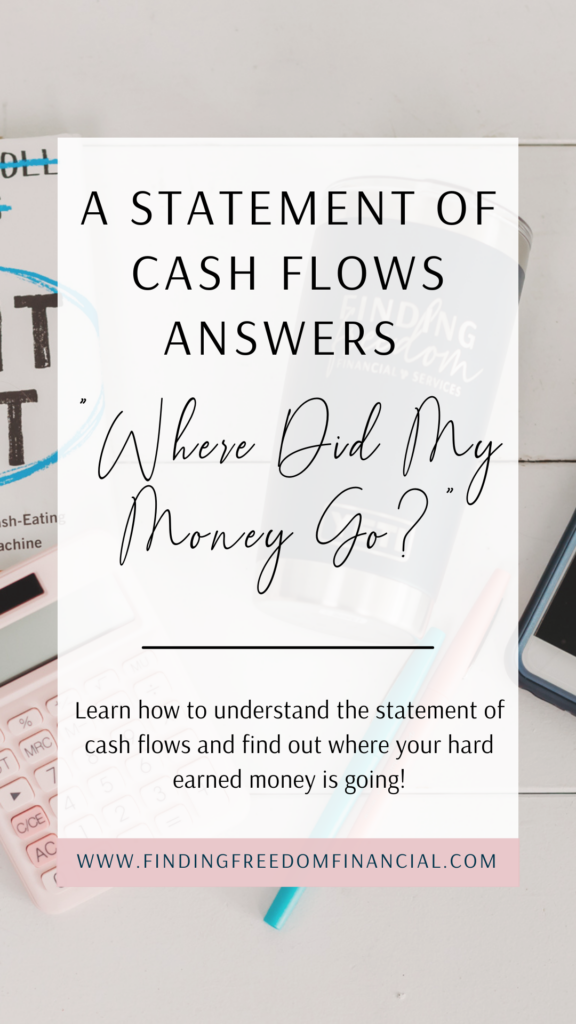A Statement of Cash Flows Answers “Where Did My Money Go?”
Have you ever gotten to the end of a successful business month and wondered, “Where did all that money go?!” A statement of cash flows (SOCF) can help you answer that question!
Most of the business owners I work with are familiar with the Profit & Loss statement (if you’re not, no shame! You can check out this post to get a little more familiar with it, so maybe you can see that your bottom line was KILLER last month, but your bank account simply doesn’t reflect it.
The best way to see where your money actually goes each month is to look at the Statement of Cash Flows (SOCF). Unfortunately, this is a report that many business owners are unfamiliar with, but any good bookkeeping software (like Quickbooks Online) will have this report readily available for you! So, let’s cover the highlights…

The Layout of the Statement of Cash Flows
The statement of cash flows is broken into 3 separate sections: Operating Activities, Financing Activities, and Investing Activities.
Most of your activity is going to be listed under the “Operating Activities” section, and this is the first section. The first line on the SOCF is your net income, which you can see broken out on your P&L. It then makes various cash adjustments to show you how the actual cash moved in & out of your business during that same period. Adjustments for things that don’t hit your P&L, such as payments towards your credit cards, sales tax & payroll liabilities, and inventory purchases.
The financing section of a statement of cash flows includes any other payments to debts or to the owner’s. So, if you make a mortgage payment every month for the building you own, any principal payments you’ve paid will be reflected in this section (NOT on your P&L). If you’ve withdrawn any owner’s draws outside of payroll, those payments to yourself will also be included in the financing section as well.
The last section will be the investing section, and this is typically used to show any more significant funds that are re-invested back into the business through asset purchases (or sale of these types of assets). This could include purchasing a whole new point of sale/computer system, upgrading the security system in your store, or maybe even buying a van or a truck for the business to do mobile events! Larger purchases like these are typically recorded as assets (if they’re over $2,500), and the money spent typically does not get reflected on your P&L when the purchase is made.
How to Read a Statement of Cash Flows
Let’s look at an example statement of cash flows to see specific examples:
It’s important to understand that any NEGATIVE numbers on this report indicate a cash outflow and any POSITIVE numbers mean a cash inflow. A positive number can also indicate that you were able to receive the BENEFIT of a purchase, but you didn’t actually have to pay cash for it yet, such as putting it on a credit card, or buying something on account, that you’ll pay cash for later.
You’ll notice this sample report doesn’t include any investing activities, which is normal. Typically, you’re not consistently reinvesting money into larger purchases. But, let’s walk through the Operating and Financing activities on this report.
As previously mentioned, we start out with the Net Income. As long as you’re running your P&L date range for the same range as your Statement of Cash Flows, this net income number should be the same on both reports.
You’ll notice that there are 2 different lines for Inventory, but you may only have 1, depending on how you break out your financials. For this example, we can see that there is a positive cash inflow for “Boutique Inventory”, meaning that this business SOLD more inventory than it BOUGHT during this time frame. Her cost of goods sold expense would be higher than the actual cash that she spent during this time to replenish or buy new inventory.
In the next line for Home Decor Inventory, it’s the opposite. Since there is a negative cash flow, we know that this business purchased more inventory than it sold during this same time frame, so it’s cost of goods sold expense would actually be lower than the cash spent used to replenish or buy new inventory.
It’s worth noting that if you’re always expensing your inventory when you purchase it, you won’t be able to see this level of insight into your business, and your profit margins are not going to be accurately reflected on your P&L. More more information on that, I recommend you check out this post on Understanding Inventory vs Cost of Goods Sold in Retail.
For any credit cards listed, a negative amount indicates that the balance of that card was paid down during the month, so the payments actually made to the card are larger than any new charges put on the card during that time frame. As a reminder, you are able to claim the expenses on your P&L when those charges hit your credit card, but that doesn’t mean that the cash immediately leaves your bank account. That’s why this type of adjustment happens on your statement of cash flow.
The last example is showing the sales tax payable. As I’m sure you’re aware, if you sell taxable products in your business, you are always paying for the month/quarter/year prior to the one that you are in. So, if you’re a monthly filer, the amounts that you pay the state THIS month are actually to pay for what you collected from your customers LAST month. In the example above, the amount is negative, which indicates that this business paid more in sales tax during this time frame than was collected from customers last month (essentially indicating that there were more taxable sales in the month prior to this – and higher sales tax was collected in the month prior).
Overall in the operating activities section, you can see that even though the P&L showed a Net Income of nearly $21,000, there was actually only a positive inflow of cash of about $3,500. And that’s just in the operating activities!
Under the financing activities, we see any debt or owner’s payments. In most cases, these will always be negative amounts, UNLESS you take on new debts or invest your own personal money back into the business.
But, in this example, you can see the amounts paid towards the principal balances on the Truck Loan and the Mortgage that’s held by this business, and the additional owner’s draw that the owner took out of her business.
Overall, an additional $16,000+ left the business for these financing payments.
The final section will give you the overall change in cash – either the net cash increase (or decrease, if that number is negative), and how that’s actually reflected in your cash balances.
In our example, there was an overall cash decrease of $13,148.41, which decreased our cash balance during the month from $137,811.09 to $124,662.68.
These 2 different cash numbers should match your balance sheet balances as well, if you ever want to verify and take a closer look.
In Summary
The statement of cash flows can be confusing at first, but I challenge you to start looking at it every month to ensure you know where all your hard-earned money is going! I know it can feel discouraging to feel like you had a great sales month, but the bank account just doesn’t reflect it. That’s why having a solid understanding of how the actual cash flow plays into your finances can be a HUGE help in helping you feel more confident.
If you have any questions on how to read your own statement of cash flows, my DM’s are always open on Instagram.
Here’s to finding your own version of freedom,

Hi, I'm Megan!
Bookkeeping for the retail industry has some unique complexities that take extra time to manage to ensure accuracy. At Finding Freedom Financial Services, I provide done-for-you bookkeeping services for boutique owners that accurately track these complexities for you so you can have more time and focused energy to dedicate to running your stores. If you’re ready to get your time back, apply to work with me today!